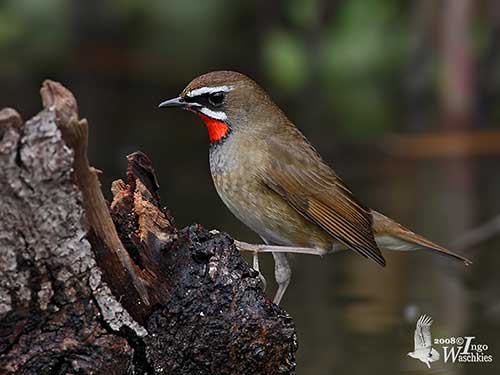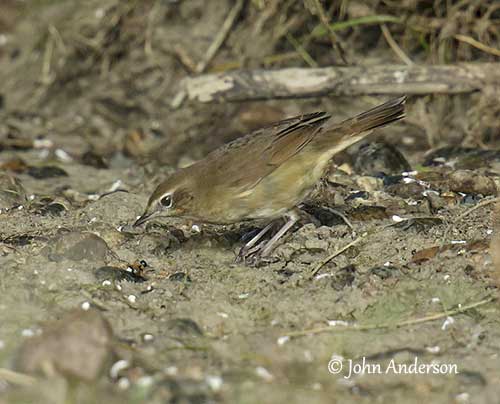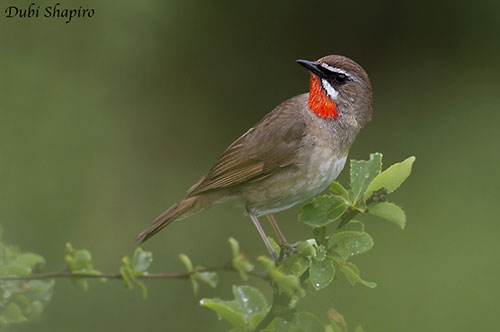
Fr: Rossignol calliope
Ang: Siberian Rubythroat
All: Rubinkehlchen
Esp: Ruiseñor Calíope
Ita: Calliope
Nd: Roodkeelnachtegaal
Sd: rubinnäktergal
Photographers:
John Anderson
John Anderson Photo Galleries
William Price
PBase-tereksandpiper & Flickr William Price
Dubi Shapiro
Dubi Shapiro Photo Galleries & Dubi Shapiro's Pictures on IBC
Ingo Waschkies
Bird Photography
Text by Nicole Bouglouan
Sources:
HANDBOOK OF THE BIRDS OF THE WORLD Vol 10 by Josep del Hoyo-Andrew Elliott-David Christie - Lynx Edicions - ISBN: 8487334725
Robins and Chats Par Peter Clement – Editeur: Bloomsbury Publishing, 2016 – ISBN: 1408155966, 9781408155967 - 688 pages
A Guide to the Birds of the Philippines Par Robert Kennedy, Pedro C. Gonzales, Edward Dickinson, Hector C. Miranda, Jr, Timothy H. Fisher – Editeur: OUP Oxford, 2000 – ISBN: 0198546688, 9780198546689 - 369 pages
A Photographic Guide to the Birds of India: And the Indian Subcontinent... Par Bikram Grewal, Bill Harvey, Otto Pfister – Editeur: Princeton University Press, 2002 – ISBN: 069111496X, 9780691114965 - 512 pages
Wikipedia, the free encyclopaedia
What Bird-The ultimate Bird Guide (Mitchell Waite)
Thai National Parks - Siberian rubythroat
Ornithologie – AVES - Rossignol calliope
Siberian Rubythroat
Calliope calliope
Passeriformes Order – Muscicapidae Family
INTRODUCTION:
The Siberian Rubythroat was formerly included in the family Turdidae (Thrushes), but it is now considered an Old World Flycatcher of the family Muscicapidae.
It breeds throughout Asia and Eastern Europe, and winters in S Asia. It is an annual migrant through W Aleutians and St Lawrence Island. It can be found in open grasslands, scrub and thickets, up to 1,500 metres of elevation. It is fairly terrestrial and forages on the ground and in bushes.
The Siberian Rubythroat is fairly common throughout its wide range, and the population is currently stable.

DESCRIPTION OF THE BIRD:
Biometrics:
Length: 16-16 cm
Wingspan: 25 cm
Weight: 16-29 g
The Siberian Rubythroat adult male in breeding plumage has olive-brown upperparts from crown to tail. The greater wing- coverts are tipped buff, forming a narrow wingbar. The primaries are edged cinnamon.
On the underparts, chin and throat are red. Upper breast and sides of lower throat are brownish-grey, whereas centre of breast, belly and undertail-coverts are whitish. The flanks are washed olive-buff.
On the head, the crown is olive-brown. Eyebrow and malar stripe are white and lores are black. The malar stripe is bordered with black.
The bill is blackish with paler base of lower mandible. The eyes are dark brown. Legs and feet are greyish-pink.
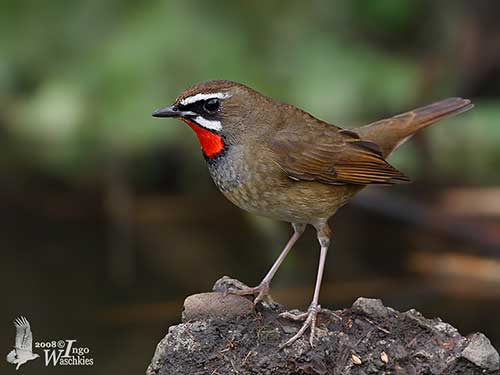
In non-breeding plumage, the male has greyer breast and black bill.
The adult female resembles male, but she has less distinct facial pattern. The throat is pink or white with no black border. Eyebrow and malar stripe are less distinct and the lores are paler. The breast is mostly browner.
The juvenile resembles juvenile European Robin or Common Nightingale.
RANGE:
The Siberian Rubythroat breeds in C Urals Mts and Siberia, E to Anadyr, Kamchatka, Commander Islands, and S to N Mongolia, N Korea, N Japan and Kuril Islands, also C China.
It winters in S and SE Asia, Taiwan and Philippines.
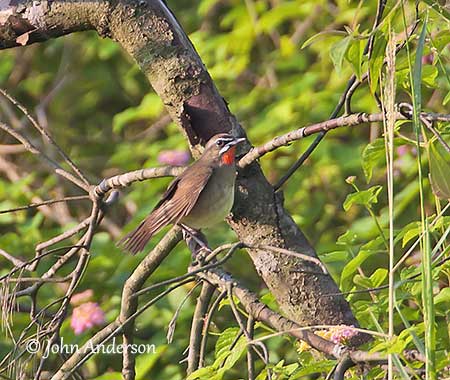
HABITAT:
The Siberian Rubythroat breeds in lowland taiga where it is most widespread, and also in river valleys, subalpine thickets, open dry steppes with tall grass and bushes and rocky mountain slopes.
It usually avoids the dense coniferous forest, but it can be found at edges of bogs or pine forest. They are most numerous around clearings in mixed or broadleaf woods. It is mostly a lowland breeder, although in Siberia, it may breed in stunted pines at or above the treeline. In Hokkaido, N Japan, it breeds in coastal bushes, grassland and thickets of dwarf pines, up to 2,000 metres of elevation.
In winter, it frequents dense thickets and scrub, abandoned cultivated fields, roadside vegetation, hedges, long grass, reeds, suburban parks and gardens, often near streams or standing water.
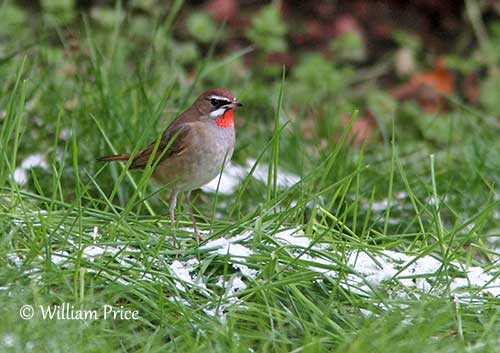
CALLS AND SONGS: SOUNDS BY XENO-CANTO
The Siberian Rubythroat gives hard, deep “tschuck” and we can also hear a loud, clear, rising “ee-uh” or “se-ic”.
The song is a sweet, scratchy warble, a varied series of rising and falling warbling notes often given in quick succession and interspersed with lower and harsher notes, described as “wit suuu it, sit sit suuu we see see…”
During the song, the red throat feathers are puffed out. This song is usually given by males in early morning and evening and sometimes at night too.
BEHAVIOUR IN THE WILD:
The Siberian Rubythroat feeds primarily on insects and larvae including ants, wasps, beetles, mosquitoes, bugs and spiders. It also consumes aquatic prey such as molluscs, crustaceans and aquatic insects caught along the seashore on passage during migration.
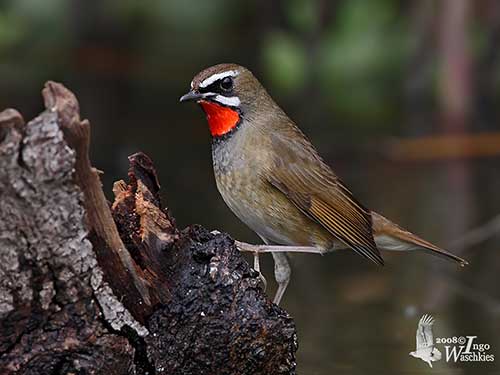
The Siberian Rubythroat often skulks in dense vegetation. It feeds on the ground where it runs and hops, usually with the tail cocked high and the wings held below the body.
It forages alone, in pairs or in family groups in summer. During migration and winter, they may form loose flocks of up to 60 individuals. They forage low down in vegetation, in reeds and grasses.
The Siberian Rubythroat is monogamous and territorial during the breeding season. The male defends the territory. During the displays, it raises and flicks its tail and also chases the female through the territory. We can also suggest that the red throat feathers are enhanced by adapted postures, including when the male sings from perches.
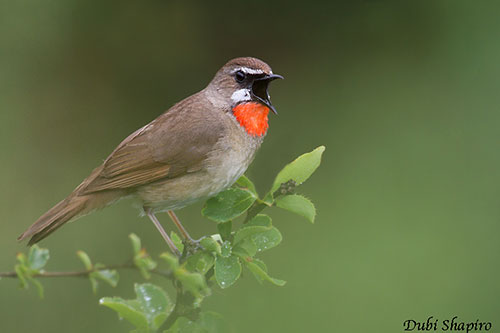
The Siberian Rubythroat is migratory. They leave the breeding range from late August/mid-September in N areas, and by early October in Transbaikalia.
They return to the breeding range in Mongolia and S Russia from middle to late May, but between late May and early June in N range.
Vagrants are recorded in Europe, Alaska, Malaysia and New Guinea.
The flight of the Siberian Rubythroat is fast and direct, with rapid wingbeats.
REPRODUCTION OF THIS SPECIES:
The breeding season takes place between May and July in Russia, with peak laying in early June. This species produces a single brood per season.
The nest is placed on the ground or just above, under dense bush or in grass tussock. It is a loose cup or a domed structure made with fine grasses and roots, and lined with plant down and animal hair.
The female lays 4-6 pale blue or greenish eggs with fine darker markings. She incubates alone during two weeks and the young fledge 12 days after hatching. They are fed by both parents and remain together for about two weeks before dispersing.
